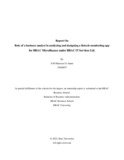| dc.contributor.advisor | Shuvo, Mr. Shihab Kabir | |
| dc.contributor.author | Amin, S M Maisoon Ul | |
| dc.date.accessioned | 2022-08-31T10:00:57Z | |
| dc.date.available | 2022-08-31T10:00:57Z | |
| dc.date.copyright | 2022 | |
| dc.date.issued | 2022 | |
| dc.identifier.other | ID: 19204037 | |
| dc.identifier.uri | http://hdl.handle.net/10361/17142 | |
| dc.description | This internship report is submitted in partial fulfillment of the requirements for the degree of Bachelor of Business Administration, 2022. | en_US |
| dc.description | Cataloged from PDF version of internship report. | |
| dc.description | Includes bibliographical references (page 32). | |
| dc.description.abstract | Business analysis is an important step to discover and emphasize the need for change in the way
firms run, as well as to aid in such transformation. We can promise that an organization receives
these benefits through the efficient application of business analysis, thereby enhancing the way
they do business. A business analyst is ultimately responsible for identifying and resolving
problems impacting the business solution, and works closely with the project manager and design
team to examine existing business processes and provide ideas for improvement. Process design,
in my opinion, is the most important topic that must be prioritized. A process design is used
whenever there is a requirement to examine or characterize the workflow in order to increase
production, effectiveness, efficiency, economy, or profitability.In my circumstance, process
design was crucial in resolving the complicated interaction between each stakeholder when
creating the fintech-monitoring system. Furthermore, BRAC IT as an organization is becoming
increasingly reliant on business analysts (or BAs) to help guide them through this digital
transformation, examining data patterns and industry trends to determine the best way to adapt
products and processes in order to add value for customers and stakeholders.
This study delves further into the notion of process design and prototyping in business analysis
utilizing behavioral UML diagrams for designing human-centric fin-tech solutions. Furthermore,
it will aid in determining the potential influence of Business Analysis in the software development
business throughout the world. | en_US |
| dc.description.statementofresponsibility | S M Maisoon Ul Amin | |
| dc.format.extent | 32 Pages | |
| dc.language.iso | en_US | en_US |
| dc.publisher | Brac University | en_US |
| dc.rights | BRAC University Internship reports are protected by copyright. They may be viewed from this source for any purpose, but reproduction or distribution in any format is prohibited without written permission. | |
| dc.subject | Fintech | en_US |
| dc.subject | Microfinance | en_US |
| dc.subject | Business Analysis | en_US |
| dc.subject | Business Analyst | en_US |
| dc.subject | Human-centric Design | en_US |
| dc.subject | Process Design | en_US |
| dc.subject | UML Diagram | en_US |
| dc.subject | Figma | en_US |
| dc.subject | Prototype | en_US |
| dc.subject | UI/UX Design | en_US |
| dc.subject.lcsh | Microfinance--Bangladesh. | |
| dc.subject.lcsh | BRAC (Organization) | |
| dc.subject.lcsh | Rural credit--Bangladesh. | |
| dc.title | Role of a business analyst in analyzing and designing a fintech-monitoring app for BRAC Microfinance under BRAC IT Services Ltd. | en_US |
| dc.type | Internship report | en_US |
| dc.contributor.department | BRAC Business School, BRAC University | |
| dc.description.degree | B. Business Administration | |

